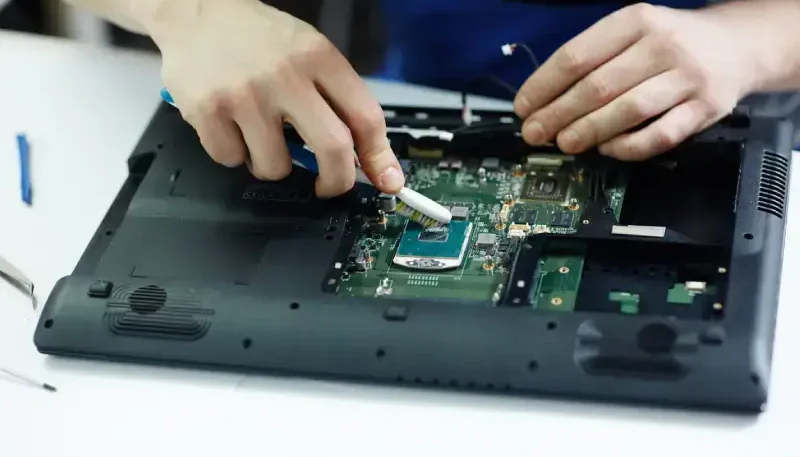Our PCs and laptops have become integral parts of our lives, serving as tools for work, communication, entertainment, and more. When these digital lifelines encounter issues, it can be stressful, but attempting repairs without taking proper precautions can lead to more harm than good. In this blog, we will explore the precautions and best practices to follow when dealing with PC/laptop repairs, helping you maintain the integrity of your device while ensuring your safety.
- Safety First: Unplug and Disconnect
Before you embark on any repair journey, safety should be your top priority. Ensure your PC or laptop is completely powered off and unplugged from any electrical source. If you’re working on a laptop, remove the battery as well. This prevents any electrical shocks or accidents during the repair process.
- Backup Your Data
One of the most critical precautions is to back up your data. Data loss can be devastating, and the repair process can sometimes involve data loss risks. Regularly back up your important files and documents to an external drive, cloud storage, or a separate computer. This ensures that even if things go awry during repairs, your data remains safe.
- Diagnostic Tools: Know What You’re Dealing With
To effectively tackle PC/laptop repairs, you need to diagnose the issue accurately. This involves identifying the problem by examining the symptoms and using diagnostic tools, which can be both software and hardware-based. Understanding the root cause of the problem is crucial as it guides the repair process and helps you avoid unnecessary fixes.
- Anti-Static Precautions: Protect Sensitive Components
Electrostatic discharge (ESD) can damage sensitive electronic components in your PC or laptop. To prevent this, ground yourself by wearing an anti-static wristband or touching a grounded metal object before handling internal components. Work on an anti-static mat in an ESD-protected environment. These precautions will safeguard against unintentional damage due to static electricity.
- Documentation: Take Notes and Photos
During the repair process, take detailed notes and photographs of the disassembly and connections. This will help you remember how to reassemble your device correctly. It’s easy to forget which cable goes where, so documentation ensures that you can reverse the process with confidence.
- The Right Tools for the Job
Having the right tools is essential for successful PC/laptop repairs. This includes screwdrivers, pliers, thermal paste, and specialty tools if needed. Using the wrong tools can result in damage to delicate components, stripped screws, and other complications. Invest in a quality tool kit to make your repair process smoother.
- Replacement Parts: Buy from Reliable Sources
If your repair requires replacement parts, only purchase them from reputable sources. Buying low-quality or counterfeit parts can lead to compatibility issues and further damage to your device. Always double-check the compatibility of the replacement parts with your specific model to ensure a seamless repair process.
- Follow Repair Guides and Tutorials
There’s a wealth of knowledge available online, including repair guides and video tutorials for common PC/laptop issues. These resources can provide step-by-step instructions for various repairs. Following reliable guides ensures that you are on the right track and reduces the chances of making costly mistakes.
- Organization: Keep Components and Screws Sorted
As you disassemble your PC or laptop, organize the components and screws you remove. Use small containers, plastic bags, or even a magnetic mat to keep everything sorted. This practice simplifies reassembly and minimizes the risk of losing or misplacing essential components.
- Stay Patient and Methodical
Rushing through a repair can lead to errors and frustration. Take your time, follow each step carefully, and be patient. Rushing can lead to accidental damage and, in some cases, irreversible mistakes. Methodical, careful work pays off in the end.
- Test Before Reassembling
Before you reassemble your PC or laptop, test the repaired components to ensure they are working correctly. This prevents the need for disassembly if further adjustments are necessary. It’s better to catch issues early in the process.
- Seek Professional Help When Necessary
Not all repairs can or should be done by amateurs. Some issues, such as a damaged motherboard or complex soldering tasks, require professional expertise. Don’t hesitate to seek help from a qualified technician when the repair is beyond your skill level. Attempting complex repairs without the necessary expertise can lead to further damage.
- Backup Again
After the repair is completed and your PC or laptop is functioning properly, take one final precaution: create another backup of your data. This ensures that you have an up-to-date copy of your important files in case anything goes wrong in the future.
In conclusion, while DIY PC/laptop repairs can be rewarding and cost-effective, they also carry risks. By following these precautions and best practices, you can increase your chances of a successful repair while protecting your valuable device and data. Remember, when in doubt, it’s always a wise choice to seek professional assistance to avoid costly mistakes and further damage.





